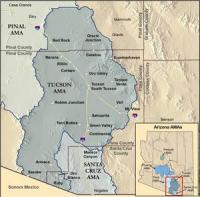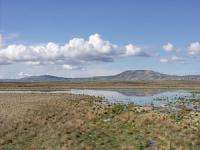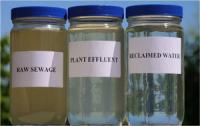-
Climate change to deplete some U.S. water basins, reduce irrigated crop yields
A new study by MIT climate scientists, economists, and agriculture experts finds that certain hotspots in the country will experience severe reductions in crop yields by 2050, due to climate change’s impact on irrigation. The most adversely affected region, according to the researchers, will be the Southwest. Already a water-stressed part of the country, this region is projected to experience reduced precipitation by midcentury. Less rainfall to the area will mean reduced runoff into water basins that feed irrigated fields.
-
-
Groundwater pumping drying up Great Plains streams
Farmers in the Great Plains of Nebraska, Colorado, Kansas, and the panhandle of Texas produce about one-sixth of the world’s grain, and water for these crops comes from the High Plains Aquifer — often known as the Ogallala Aquifer — the single greatest source of groundwater in North America. If pumping practices are not modified, scientists warn that these habitats will continue to shrink, and the fish populations along with them.
-
-
Safe water for slum dwellers
Attempts to deliver safe water to people living in some of the world’s poorest slums are falling at the final hurdle, according to experts. Sewage-contaminated drinking water causes serious illness such as diarrhea and other gastrointestinal and stomach problems – putting millions of lives at considerable risk each year. Globally, there are 1.7 billion cases of diarrhea annually resulting in over 0.5 million deaths of children under five years old. New research has shown that despite good progress, millions of slum dwellers are still exposed to considerable risk because water supplies are being contaminated by human waste just meters from the family home.
-
-
Water management interventions push water scarcity downstream
Human interventions to harness water resources, such as reservoirs, dams, and irrigation measures, have increased water availability for much of the global population, but at the same time, swept water scarcity problems downstream.
-
-
Helping repair California's water infrastructure
Recent extreme weather has put increased stress on California’s aging water infrastructure and highlighted the fact that the state must invest billions to improve and repair its civil infrastructure. The California Policy Center reports the infrastructure is currently designed to serve 20 million people in a state with a population of 40 million. The state relies on CSU water management, engineering, agriculture, and construction management experts to renovate aging dams, canals and aqueducts.
-
-
New water filtration technology uses 1,000 times less energy
With global demand for clean water increasing, there is a continuing need to improve the performance of water treatment processes. A new process for water filtration using carbon dioxide consumes one thousand times less energy than conventional methods, scientific research published this week has shown.
-
-
Europe’s economy vulnerable to global water scarcity, drought
A new study of the impacts that increasing water scarcity and drought may have on the European Union’s (EU) economy finds that around 38 percent of the EU’s water demand lies outside its borders because many of the goods consumed by its citizens or used by its businesses are produced abroad. “The highest risk that the European meat and dairy sector will face due to climate change and weather extremes lies outside its borders. This is because it is highly dependent on soybean imports from locations that are vulnerable to water scarcity and drought,” says one expert.
-
-
Home styles linked to high water use
Affluent neighborhoods with lawns — and occasionally swimming pools — use up to ten times more water than neighborhoods with higher density housing with less landscaping, according to a new study. The study points to the water-saving benefits of high-density neighborhoods such as more use of hardscaping, non-vegetative landscapes, as well as native plants in landscapes, which use less water than lawns.
-
-
Desert communities and the search for hidden water

In the 1800s, cowboys, ranchers, and miners quarreled over water in the American Southwest, over where to find it, and who could use it. Today, desert communities throughout the Southwest are still putting water availability at the top of their municipal agendas. one area stands out from the rest: the upper Santa Cruz Basin in Arizona has shown a remarkable capacity to store water. What causes the higher water availability in this area?
-
-
Western U.S.: Loss in water from melting snowpack due to human influence

Peak runoff in streams and rivers of the western United States is strongly influenced by melting of accumulated mountain snowpack. A significant decline in this resource has a direct connection to streamflow, with substantial economic and societal impacts. An international team of scientists has found that up to 20 percent loss in the annual maximum amount of water contained in the western United States’ mountain snowpack in the last three decades is due to human influence.
-
-
New filtration method makes water safe to drink

Researchers have created a membrane that removes viruses from treated wastewater and makes it safe for drinking. The new ultrafiltration method does not rely on chlorine, the commonly used chemical to purify water, which can cause contamination.
-
-
Identifying, utilizing water resources in Africa drylands
Researchers say that by 2050, almost half of the world’s population will live in countries with a chronic water shortage. In African drylands, it is not a water shortage problem, but an inability to capture water for food and other uses. Israeli scientists help villagers in Ethiopia, Zambia, and Uganda to identify water sources and test water quality – and also better capture and use water which is available.
-
-
Smart handpumps predict depths of groundwater in Africa
The amount of groundwater in Africa is estimated to be over 100 time’s greater than annual renewable freshwater sources in the region. Around one million hand pumps supply groundwater to people in rural Africa. Groundwater is used by around 200 million rural Africans every day because it is a widely available, reliable, and safe source of drinking water. Yet according to a new research paper, although groundwater is critical to Africa’s growth and development, there is currently too little data to effectively manage this critical resource.
-
-
Potentially explosive methane gas mobile in groundwater, poses safety risk
Potentially explosive methane gas leaking from energy wells may travel extensively through groundwater and pose a safety risk, according to a new study. Researchers found the gas is highly mobile in groundwater, travelling far beyond the shale wells where it is drilled and changing the water chemistry. It will also escape into the atmosphere as a powerful greenhouse gas.
-
-
Roll, Jordan, Roll? -- Where the Jordan River stops flowing

A new study argues that Israel’s Jordan River may be a useful case study for the challenges facing stream restoration initiatives around the world. The Jordan River has been ravaged by unbridled population growth and defunct sewage treatment plants, and the river now has only 3 percent of its original flow. “No river enjoys better PR and has worse environmental conditions than the Jordan River,” says a researcher.
-
More headlines
The long view
Water Wars: A Historic Agreement Between Mexico and US Is Ramping Up Border Tension
As climate change drives rising temperatures and changes in rainfall, Mexico and the US are in the middle of a conflict over water, putting an additional strain on their relationship. Partly due to constant droughts, Mexico has struggled to maintain its water deliveries for much of the last 25 years, deliveries to which it is obligated by a 1944 water-sharing agreement between the two countries.
